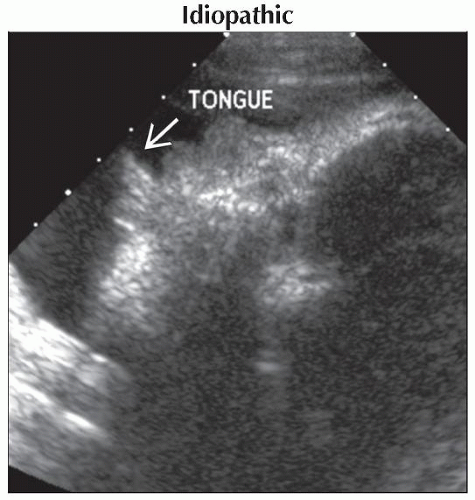Macroglossia
Anne Kennedy, MD
DIFFERENTIAL DIAGNOSIS
Common
-
Idiopathic
-
Trisomy 21
Less Common
-
Beckwith-Wiedemann Syndrome
-
Oral Mass (Mimic)
ESSENTIAL INFORMATION
Key Differential Diagnosis Issues
-
Normal fetal movements include swallowing, thumb sucking and tongue motion
-
Macroglossia implies that the tongue is too large to fit in oral cavity
-
Down syndrome fetuses may exhibit “tongue thrusting” movements in third trimester
-
Tongue protrudes intermittently due to lax muscle tone
-
-
If tongue seems “too easy to see” look carefully for facial cleft
-
Coronal view of nose/lips
-
Axial view of tooth buds
-
-
Lymphangioma may cause tongue enlargement
-
Rare amongst head and neck lymphangiomas
-
More likely to present in childhood than in fetus
-
-
Oral masses can be confusing
-
Sometimes hard to tell if a mass originates in tongue or palate
-
Epignathus typically very large with cystic/solid/calcified components
-
Helpful Clues for Common Diagnoses
-
Idiopathic
-
Structurally normal fetus
-
No signs of aneuploidy particularly trisomy 21
-
Size appropriate for dates
-
-
-
Trisomy 21
-
Correlate with a priori risk and look for sonographic markers
-
Absent nasal bone/thick nuchal fold/mild ventriculomegaly
-
Congenital heart disease, particularly atrioventricular septal defect
-
Duodenal atresia/echogenic bowel/pyelectasis
-
Short humerus/femur
-
Clinodactyly/sandal gap toe
-
-
Helpful Clues for Less Common Diagnoses
-
Beckwith-Wiedemann Syndrome
-
Macroglossia in 97%
-
Fetal overgrowth in 88%
-
Omphalocele/umbilical hernia in 80%
-
Organomegaly
-
At increased risk for severe neonatal hypoglycemia sufficient to cause brain injury
-
Childhood tumors develop in up to 10% of cases (Wilms tumor most common)
-
Image Gallery

Sagittal transabdominal ultrasound during the course of a growth assessment for poor maternal weight gain showed this fetus “licking” the placenta. The tongue
 fit in the mouth, and the infant was normal at birth. fit in the mouth, and the infant was normal at birth.Stay updated, free articles. Join our Telegram channel
Full access? Get Clinical Tree
 Get Clinical Tree app for offline access
Get Clinical Tree app for offline access

|